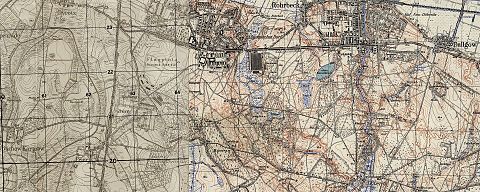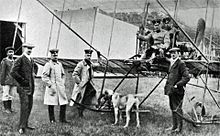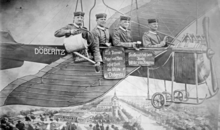Döberitz airfield


The airfield Döberitz is a former German military airfield in Brandenburg , around 25 kilometers west of Berlin , on the road between Berlin and Hamburg ( B 5 ), the beginning of 1910 with the establishment of the Provisional flier commands Döberitz first military airfield of the German Empire Air Force has been set up. In May 1910, the Döberitz Provisional Aviation School began operations. The air base was part of the Döberitz military training area . The Döberitz airfield is the origin of the air forces of the German Empire.
history

Beginnings
In 1901, the received observation balloon the airship troops the first airship battalion , which was housed at the site Döberitz; however, the airships operated from the Berlin-Staaken airfield .
Despite the focus of the German air forces on airship travel, some high-ranking officers, who saw the future of aviation in the new aircraft that were also permanently present at the Berlin-Johannisthal airfield from 1909 , pointed out the importance of the new apparatus to the War Ministry. Thereupon, on May 1, 1910, the "Provisional Aviation School Döberitz" was officially opened at the Döberitz airfield, whose take-off and landing area had been planed by army spies since March 1910.
The first military pilots were trained from May 1910 at the expense and organized by Walther Huth (a founder of the Albatros Flugzeugwerke ) on a Farman III imported from France . The first flight instructor at the Döberitz Aviation School was Simon Brunnhuber , Huth's chauffeur, who had been trained as a pilot in France by Hubert Latham at Huth's expense . The commanding officer was Captain Wolfram de le Roi . Brunnhuber's training in 1910 was accident-free. The Farman III, which Huth had previously given the military free of charge, was then purchased on December 18, 1910 as the first German military aircraft with the army designation "B 1". Among the first trained officers were first lieutenant Franz Geerdtz (1877-1958) and the lieutenants Walter Mackenthun , Rudolf Freiherr von Thüna (born April 9, 1887, † June 9, 1936) and Eugen von Tarnóczy .
The soldiers were initially housed in large tents. By 1914 they were resettled in permanent houses - with a stopover in corrugated iron barracks; the camp, called barracks camp, was built on Berlin-Hamburger-Chaussee between the present-day districts of Rohrbeck in the west and Dallgow in the east.
Since the air force was not a separate branch of service until then , it was subordinate to the army .
From 1914
The central training and testing center for the newly formed air force was set up. " Flying aces " from both world wars were trained here. After 1918, monitored by the Interallied Aviation Monitoring Commission (ILÜK), many of the war technical systems (including the first flight simulator ) were dismantled or destroyed. Until 1930 it also offered hiding places for the Black Reichswehr .
time of the nationalsocialism
During the National Socialist era, one of the largest military training centers for Wehrmacht pilots was established in Döberitz. The barracks belonging to the training area were still located on the site of the old Döberitz military training area . Therefore, the testing and training of paratroopers was ideal here. In 1936, predecessor units of the later Parachute-Panzer Division 1 Hermann Göring were set up and trained here, and in the same year the Condor Legion . From 1942, Mario Zippermayr developed new, partly innovative weapon systems here, such as high-speed aircraft and the witch's cauldron project. German flight operations ceased in 1945.
From 1945
After units of the Red Army took the place , the airfield was used by Soviet military pilots until 1960. Due to technical defects, flight operations were relocated to Oranienburg .
Nature reserve
In 2000, in the course of renaturation measures in connection with the declaration of the Döberitzer Heide as a nature reserve (1997), all remaining facilities of the airfield were demolished.
Instructors and Graduates
- Oswald Boelcke
- Simon Brunnhuber , first flight instructor for German military pilots
- Ernst Canter
- Adolf Galland
- Max Immelmann
- Walter Mackenthun
- Friedrich von Mallinckrodt
- Hans-Joachim Marseille
- Manfred von Richthofen
- Eugene of Tarnóczy
- Kurt Wolff
literature
- Kai Biermann , Erhard Cielewicz: Döberitz airfield. Birthplace of military aviation in Germany . Berlin 2005, ISBN 3-86153-371-5 .
- Paul Deickert: Historical Döberitz: Döberitz as it was and as it is . Berlin 1936.
- Schmitt, Günter: When the vintage cars flew - The history of the Johannisthal airfield . Transpress, Berlin 1980, ISBN 3-344-00129-9 .
Web links
Individual evidence
- ↑ Comparison to the topographic map
- ↑ a b Biermann, Cielewicz: Flugplatz Döberitz , p. 23 ff.
- ↑ Biermann, Cielewicz: Flugplatz Döberitz , p. 17 ff.
- ↑ Schmitt: When the oldtimers flew , p. 159 ff.
- ↑ A replica of the Farman III is in the Military History Museum at Berlin-Gatow Airport .
- ↑ Biermann, Cielewicz: Flugplatz Döberitz , p. 25
Coordinates: 52 ° 30 '46 " N , 13 ° 3' 5.5" E

